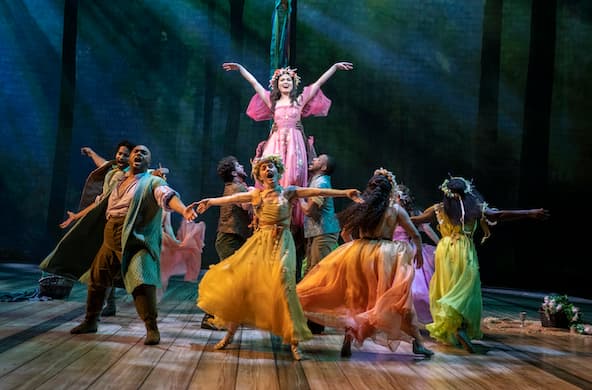Inventing Camelot
Great works of art — and musical theater in particular — are almost invariably defined by the eras that conceived them, but ‘Camelot’ is that great rarity: an artistic and pop culture work that actually defined its era.

‘Camelot’
Vivian Beaumont Theater, Lincoln Center
“By God, I shall be a king. This is the time of King Arthur, when we shall reach for the stars! This is the time of King Arthur, when violence is not strength and compassion is not weakness!”
Pop quiz: Is that from Shakespeare? Or the King James edition of The Bible? Consider these words in particular: “Violence is not strength and compassion is not weakness!” Taken out of context, you might assume that they were said by either Martin Luther King Jr. or John F. Kennedy.
This actually comes from the end of Act One of the Broadway musical “Camelot,” the final show of the legendary team of Alan Jay Lerner, who wrote the book and lyrics, and Frederick Loewe, who composed the music. These words are heard in a somewhat rewritten form in the new book by Aaron Sorkin in the latest production at the Vivian Beaumont Theater.
Great works of art — and musical theater in particular — are almost invariably defined by the eras that conceived them: “Oklahoma!” could have only been produced, and been a major hit, during the World War II era, just as “Hair” was a brilliant response to the counterculture of the late 1960s. “Camelot,” though, is something else entirely. Not merely a product of its era, it is that great rarity: an artistic and pop culture work that actually defined its era, rather than the other way around.
“Camelot” neatly frames the moment of Kennedy, Johnson, and the Great Society: the musical had its premiere on Broadway a month before the inauguration of JFK and the film version — a truly dismal movie, though surprisingly it was the no. 10 box office hit of 1967 — opened on the eve of LBJ’s last year in office, a few months before the assassinations of King and Robert Kennedy.
It’s precisely because “Camelot” and the Camelot Era are so closely intertwined that the work has never really thrived beyond the 1960s. There’s never been a full-scale revival until now (all the subsequent Broadway productions were essentially limited runs), and the new version is the first attempt — and it’s being rethought well beyond even Mr. Sorkin’s contributions — to see if “Camelot” can survive Camelot.
The story of “Camelot” the musical is essentially three stories at once, only the first of which is the saga actually presented on stage: the love triangle of Arthur, Guenevere, and Lancelot, which comes to symbolize a larger message about how the ambition to improve the lot of humanity is inevitably sabotaged by the unfortunate fact that we are all, in the end, human.
The second story of “Camelot” is the epic tale of how the three principal collaborators, Lerner, Loewe, and especially director Moss Hart, overcame impossible odds to transfer Theodore White’s “The Once and Future King,” a 1958 novel based on the Arthurian legends, to stage from page. This epic tale, which interweaves history, mythology, fantasy, romance, and, ultimately, tragedy, was hardly typical fare for Broadway musicals back then, or indeed now. Along the way, all of the creators suffered multiple health problems. There was one moment, after the out-of-town opening in Toronto, when the show was over four hours long and desperately needed work — one wag described it as “Gotterdammerung without the laughs” — when both Lerner and Hart were in the hospital at the same time. Hart lived to see the work open and, against all odds, succeed on Broadway, but the stress of the effort ultimately killed him a few months later.
The third and final story is the well-known tale of how “Camelot” defined its era, which is no coincidence. Alan J. Lerner and John F. Kennedy had known each other since boyhood, and had gone to two schools together, Choate and Harvard. It was at the latter that they also got to know Leonard Bernstein. “Camelot” expressed precisely the ideals of the Kennedy, and, subsequently, the Johnson administrations.
Lerner has spoken very movingly of the performance given by the national company — then at the Chicago Opera House — on the night of November 22, 1963. When Arthur sings the last lines, the ones about “the brief shining moment that was known as ‘Camelot,’” the entire house erupted in sobs and cries of anguish.
Lerner also said that “from that moment, the first act became the weak act and the second act, the strong one. God knows I would have preferred that history had not become my collaborator.”
He did acknowledge that the work was severely flawed — and, history aside, the second act is still a mess. Somehow, the love triangle escalates into the destruction of the Democratic ideal and even into open warfare. Mr. Sorkin’s book corrects some flaws but exacerbates others. It eliminates the magical and fantastic elements (unfortunately, one of the best songs, “Follow Me,” went along with them), stresses the history, and deals with the war scenes better. Yet somehow, now the relationships between Arthur and Guenevere, and then Guenevere and Lancelot, seem even murkier than they did in 1960.
For all of its influence on the culture, “Camelot” is nothing less than a classic musical — but we can debate whether it is a great or even a very good one. Undeniably, “Camelot” should be seen and heard because of the songs that, in their original orchestrations, sound as glorious as ever (even though the ending of “What Do the Simple Folk Do” has been meaninglessly truncated); in Arthur’s final words, they sparkle. To paraphrase JFK himself, the glow from its fire can truly light the world.

